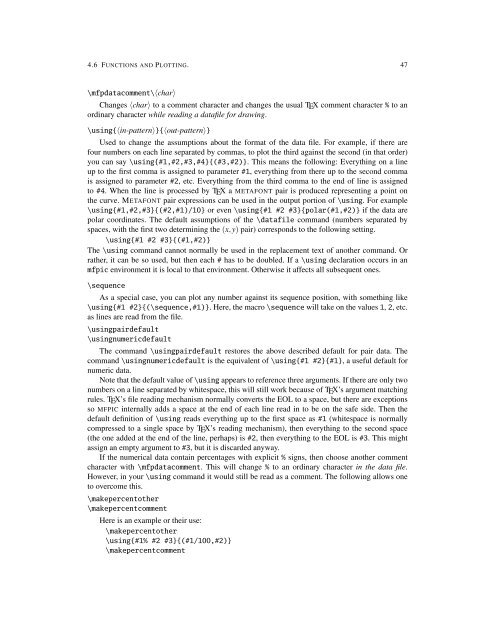You also want an ePaper? Increase the reach of your titles
YUMPU automatically turns print PDFs into web optimized ePapers that Google loves.
4.6 FUNCTIONS AND PLOTTING. 47<br />
\mfpdatacomment\〈char〉<br />
Changes 〈char〉 to a comment character and changes the usual TEX comment character % to an<br />
ordinary character while reading a datafile for drawing.<br />
\using{〈in-pattern〉}{〈out-pattern〉}<br />
Used to change the assumptions about the format of the data file. For example, if there are<br />
four numbers on each line separated by commas, to plot the third against the second (in that order)<br />
you can say \using{#1,#2,#3,#4}{(#3,#2)}. This means the following: Everything on a line<br />
up to the first comma is assigned to parameter #1, everything from there up to the second comma<br />
is assigned to parameter #2, etc. Everything from the third comma to the end of line is assigned<br />
to #4. When the line is processed by TEX a METAFONT pair is produced representing a point on<br />
the curve. METAFONT pair expressions can be used in the output portion of \using. For example<br />
\using{#1,#2,#3}{(#2,#1)/10} or even \using{#1 #2 #3}{polar(#1,#2)} if the data are<br />
polar coordinates. The default assumptions of the \datafile command (numbers separated by<br />
spaces, with the first two determining the (x,y) pair) corresponds to the following setting.<br />
\using{#1 #2 #3}{(#1,#2)}<br />
The \using command cannot normally be used in the replacement text of another command. Or<br />
rather, it can be so used, but then each # has to be doubled. If a \using declaration occurs in an<br />
<strong>mfpic</strong> environment it is local to that environment. Otherwise it affects all subsequent ones.<br />
\sequence<br />
As a special case, you can plot any number against its sequence position, with something like<br />
\using{#1 #2}{(\sequence,#1)}. Here, the macro \sequence will take on the values 1, 2, etc.<br />
as lines are read from the file.<br />
\usingpairdefault<br />
\usingnumericdefault<br />
The command \usingpairdefault restores the above described default for pair data. The<br />
command \usingnumericdefault is the equivalent of \using{#1 #2}{#1}, a useful default for<br />
numeric data.<br />
Note that the default value of \using appears to reference three arguments. If there are only two<br />
numbers on a line separated by whitespace, this will still work because of TEX’s argument matching<br />
rules. TEX’s file reading mechanism normally converts the EOL to a space, but there are exceptions<br />
so MFPIC internally adds a space at the end of each line read in to be on the safe side. Then the<br />
default definition of \using reads everything up to the first space as #1 (whitespace is normally<br />
compressed to a single space by TEX’s reading mechanism), then everything to the second space<br />
(the one added at the end of the line, perhaps) is #2, then everything to the EOL is #3. This might<br />
assign an empty argument to #3, but it is discarded anyway.<br />
If the numerical data contain percentages with explicit % signs, then choose another comment<br />
character with \mfpdatacomment. This will change % to an ordinary character in the data file.<br />
However, in your \using command it would still be read as a comment. The following allows one<br />
to overcome this.<br />
\makepercentother<br />
\makepercentcomment<br />
Here is an example or their use:<br />
\makepercentother<br />
\using{#1% #2 #3}{(#1/100,#2)}<br />
\makepercentcomment

















